Manuscript accepted on :
Published online on: 23-12-2015
Plagiarism Check: Yes
Sheeba Abraham, G. Hari Krishnan, R. J. Hemalatha, Sindu Divakaran and G. Umashankar
Department of Biomedical Engineering, Sathyabama University, Chennai-119, India.
DOI : https://dx.doi.org/10.13005/bpj/478
Abstract
The advancement in technology has lead to many innovations in the field of medicine. Nowadays most of the vital equipments are configured digitally since this field needs more meticulousness. The project aims to develop a Household Digitalized Voice Activated E-Pill Ejector module that will remind the patients to take the medicines in time with the ejection of medicine after receiving a voice feedback. To cure the disease one has to take the exact dosage of medicine on time, over dosage of medicine can be fatal to the patient. Thus the Digitalized E-Pill Ejector module will help to reduce such problems by reminding the patient to consume the right medicine on time. Aged people are mainly benefited by this innovation. The proposed system consist of an Embedded System based Microprocessor Unit which is the central controller module that controls the entire operation of the E-Pill Ejector module along with a Clock generating unit, a partitioned box to load medicines according the doctor’s prescription, Buzzer unit as reminder, an RTC(Real Time Clock) module to feed the time schedule, Keyboard interface to set the time schedule, motors with its driver units to rotate the medicine loaded cabin and a voice recognition module to eject the medicine after the speech recognition.
Keywords
E-pill ejector; microprocessor; speech recognition
Download this article as:| Copy the following to cite this article: Abraham S, Krishnan G. H, Hemalatha R. J, Divakaran S, Umashankar G. Design of Voice Based Pill Ejector System. Biomed Pharmacol J 2014;7(1) |
| Copy the following to cite this URL: Abraham S, Krishnan G. H, Hemalatha R. J, Divakaran S, Umashankar G. Design of Voice Based Pill Ejector System. Biomed Pharmacol J 2014;7(1). Available from: http://biomedpharmajournal.org/?p=2926 |
Introduction
During the past century the life expectancy of the living world has increased by more than 50 percent due to advancements in medicine. Utilizing the groundbreaking telemedicine technology, the Pill Ejector has been designed in such a way that it can help the elderly patients to take their medicines on time without any external help. It is an automatic medication dispenser that removes the stress and danger of missing or incorrect doses of medicine. Thus the machine helps them to live an independent life with reliable functionality. There has been alarming results showing the fatal effects of medication error. The main aim of E-Pill Ejector is to reduce the medication errors and the fatal effects of it. Once the device is loaded with pills and the time schedule is set, it reminds the patient to take the right medicine on time. The Digitalized Voice Activated E-Pill Ejector is designed using telemedicine technology and it removes the stress and danger of missing or incorrectly administering medicine doses.
The main step in the treatment of any disease is not just prescribing medication but also for the right administration of the drugs. Thus this machine automatically gives the right pills at the right time and also sounds an alarm to remind the patient about the medication time. Once a voice feedback is received from the patient, the pills are ejected. The proposed model makes it easy especially for the elderly people who has one or more chronic condition or those who have to take multiple medications. This device mainly assists people with chronic device or those suffering from heart diseases, osteoporosis, diabetes or cancer.
Materials and Methodlogies
The block diagram as shown in figure 1 consists of Embedded System based microcontroller unit, Keyboard interface- To set the time schedule, LCD Interfacing- display module, Real time clock, Buzzer Unit- As reminder, Voice recognition module- To eject the medicine after the speech recognition box- To load medicine, Motors and Power Supply. The vital part of the E-pill is the microcontroller which controls the entire operation of the pill ejector. The working of the E-pill is initiated by entering date and time of medication using the keyboard interface of the machine. Once the data is entered, the LCD displays it. Real time clock counts seconds, minutes, hours, date of the month, month, day of the week and year with leap-year as shown in figure 2.The scheduled time is fed into the Real Time Clock. Once the time is set, the buzzer rings accordingly thus reminding the patient to take the medicine in time. On hearing the buzzer ring, the patient gives a voice input which is recognized by the voice recognition module and thus the buzzer stops which leads to the rotation of stepper motor and thereby ejects the pill.
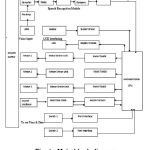 |
Figure 1: Main block diagram
|
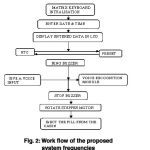 |
Figure 2: Work flow of the proposed system frequencies
|
Results and Discussion
The Digitalized Voice Activated E-Pill Ejector is an advanced technology of pill delivery system. This advanced model is simpler and more user friendly with light weight materials (polycarbonate material used for construction of cabins of pill ejector). It is less expensive compared to most of the available systems and the mechanical components are simpler. They maybe designed to assist a large number of patients in hospitals and health centers. This model is portable, fixed anywhere and can be transplanted easily. It has a capacity of storing 4 days supply of pills up to 3 times per day.LCD display is incorporated for ease of displaying information about the date and time of medication as shown in figure 3. The maximum security in pill delivery is guaranteed to the patient as the i2c protocol is strictly maintained. The patient data for the medication is entered using matrix keyboard .When the preset time is reached, the buzzer starts ringing and waits for the voice input from the patient to eject the pills from the device.
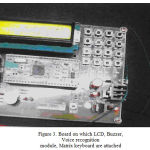 |
Figure 3: Board on which LCD, Buzzer, Voice recognition module, Matrix keyboard are attached
|
The implemented digital voice activated E-pill ejector with the pill container is as shown in figure 4. The tablets are filled in according to different sectors inside the cabin as shown in figure 5 after execution of the program the required tablet was ejected from particular sector of the cabin as shown in figure 6. The proposed model can be attached with wheels to deliver the pills to the patient at the place where he is and can have obstacle sensor that can detect any obstacle and alternate its path. The proposed model can be modified by developing a monitoring device that stores insulin which must be kept in refrigerated cabins. The proposed model can be modified in such a way that if the patient misses a dose then this information about the missed dose will be sent to the care taker or family member or doctor concerned in the form of SMS or E-mail. The proposed model supports only 4 languages for the time being but more languages can be introduced in the near future. But for people who are illiterate a sensor can be attached that senses the touch of the patient instead of the voice recognition module.
 |
Figure 4: The Overall view of the digitalized voice activated E-Pill Ejector with the pill container
|
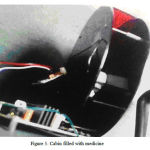 |
Figure 5: Cabin filled with medicine
|
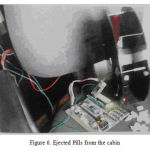 |
Figure 6: Ejected Pills from the cabin
|
Summary and Conclusion
In comparison to the available Pill Dispensers in the market, our model has a specialty of voice recognition module. This sensor attached to the system delivers the pill at the time fed in it only when the voice input is given by the patient. The voice input of a particular frequency will only be accepted by the sensor which will prohibit the misuse by others and thereby avoiding the wastage of the medicine. Since the machine was made using the ARM microcontroller it can be used for further modification. After the usage of pill ejector it was found that it reduced many hospitalizations due to missed dose and overdose. This proposed model is an error free mechanism for the ease of delivering medicines at the right time. It is available in affordable price. The additional feature of voice recognition system helps to avoid the misuse of pills which was the main aim of this model. Thus we were able to achieve these goals. This model can be concluded as a self servicing technology that reduces the risk of unnecessary medical complications and unplanned hospitalizations due to wrong intake and missing schedules of medicine. It also helps people with cognitive impairment, limited mobility and is at the risk for falls.
References
- J.R. Hawkins, Georgia Institue of Technology, Centre for Rehabilation, “Pill Dispenser for Quadripligics”, 1993.
- K. Gibert,V. Botti, R. Reig Bolano, “Artificial Intelligence Research & Development”, 2013.
- P.H. Tsai, C.Y. Yu,M.Y. Wang, J.K. Zao, H.C. Yeh,C.S. Shih, J.W.S. Liu, ”MAT: Intelligent Medication Administration Tools”,IEEE 2010.
- Akira Murai, Masaharu Mizuguchi, Masato Nishimori, Takeshi Saitoh, Tomoyuki Osaki Ryosuke konishi,“Voice Activated Wheel Chair With Collision avoidance using Sensor” ICROS-SICE International Joint Conference, 2009.
- Paul Kuwik, Thomas Largi, Matt York, Dennis Crump, David Livingston, James C, “The Smart Medical Refrigerator”IEEE, 2005.
- Sumi Helal, Mounir Mokhtari, Bessam Abdul Razak, “The Engineering Hand book of Smart Technology for Aging, Disability and Independence” Wiley Publications, 2008.
- Alan Dix, Janet Finlay, Gregory D Abowd, Russell Beale, “Huma Computer Interaction” Pearson Ltd. 3rd edition, 2004.







